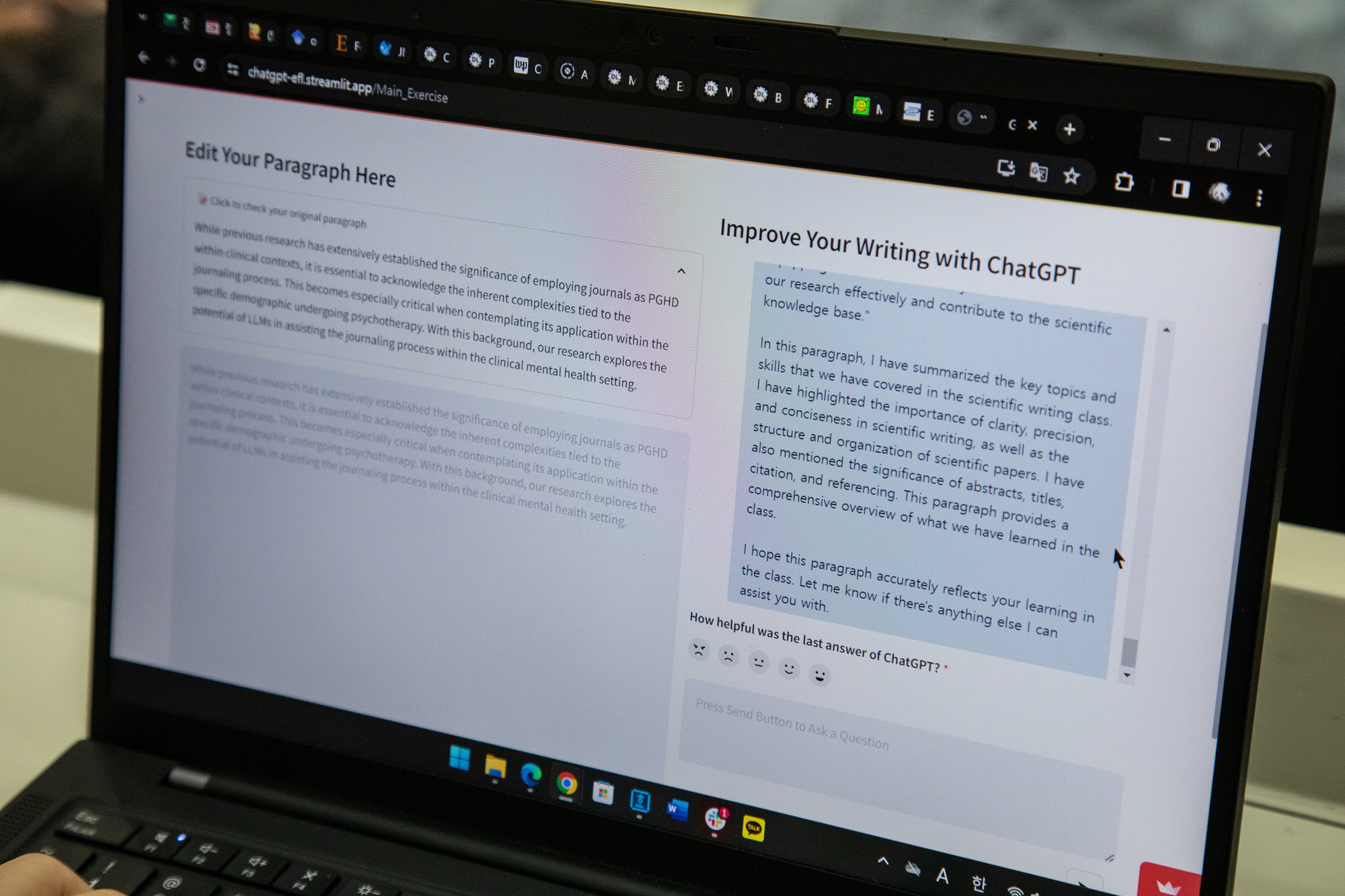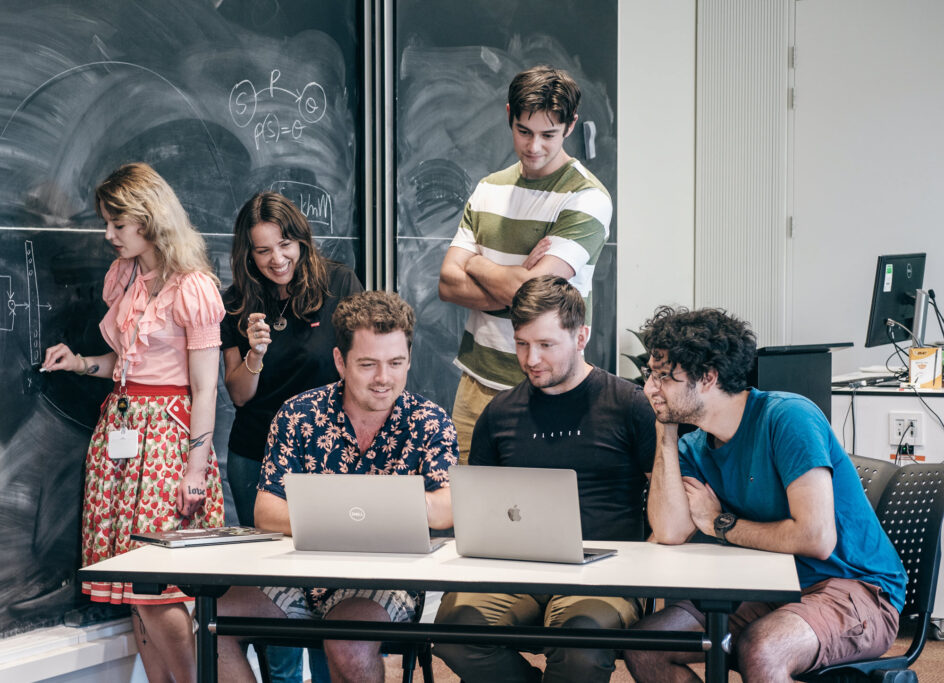In early 2023, Professor Alice Oh and her colleagues on the Korea Superior Institute of Science and Know-how (KAIST) realized they wanted to deal with the shortly rising curiosity in OpenAI ChatGPT amongst KAIST’s college students.
ChatGPT – a software developed by OpenAI that runs on massive language fashions and generates conversational responses primarily based on individuals’s prompts – might result in college students taking shortcuts of their work however may also supply academic advantages, they reasoned. The group wished to develop a analysis challenge that might have interaction college students in utilizing the know-how, so that they started excited about the right way to develop their very own chat software.
“We had been in a rush,” says Oh, a professor within the KAIST College of Computing. “Our semester began in March, and we wished to have college students begin utilizing this immediately when the semester began.”
An answer quickly emerged. In April 2023, Microsoft Analysis launched an initiative that goals to speed up the event and use of basis fashions – large-scale AI fashions educated on huge quantities of knowledge that can be utilized for a variety of duties.
Advancing Basis Fashions Analysis (AFMR) supplies tutorial researchers with entry to state-of-the-art basis fashions by way of Azure AI Services, with the objective of fostering a worldwide AI analysis neighborhood and creating strong, reliable fashions that assist additional analysis in disciplines starting from scientific discovery and training to healthcare, multicultural empowerment, authorized work and design.
The initiative’s grant program consists of 200 initiatives at universities in 15 nations, spanning a broad vary of focus areas. Researchers at Boston’s Northeastern College are engaged on an AI-powered assistant designed to seem empathetic towards staff’ well-being. At Ho Chi Minh Metropolis College of Know-how in Vietnam, researchers plan to create a fine-tuned massive language mannequin (LLM) particularly for Vietnamese. In Canada, researchers on the Université de Montréal are exploring how LLMs might assist with molecular design and the invention of recent medicine.
Accessing basis fashions may be difficult for tutorial researchers, who should typically wait to make use of shared sources that may lack the computing energy wanted to run massive fashions. Microsoft Analysis created the initiative to present researchers entry to a variety of highly effective basis models available through Azure and be sure that the event of AI is pushed not simply by business, but in addition by the educational analysis neighborhood.
“We realized that to develop AI right this moment, there may be actually a necessity for business to open up capability for academia,” says Evelyne Viegas, senior director of Analysis Catalyst at Microsoft Analysis. “These completely different viewpoints might form what we’re doing.”
With entry to Azure OpenAI Service, which mixes cutting-edge fashions from OpenAI with safety, privateness and accountable AI protections provided in Azure, Oh and the KAIST crew developed a platform that makes use of the fashions underlying ChatGPT for a chatbot to assist school college students write essays for English as a Overseas Language (EFL) programs. College students typically write at evening, when steerage from professors or instructing assistants isn’t obtainable, Oh says, and EFL college students steadily use instruments to assist navigate the challenges of writing in English.

Oh’s crew designed the chatbot to reply college students’ questions however not write their essays for them. Over a semester, 213 EFL college students used the software to refine their essays; the platform collected the scholars’ questions and essay revisions they made primarily based on the chatbot’s responses, then Oh’s crew analyzed the info and printed a paper in regards to the experiment.
The researchers discovered that some college students used the platform extensively and integrated the suggestions it offered. Many handled the chatbot like an “clever peer,” Oh says, suggesting that the know-how could be a useful complement to classroom instruction. And because the platform makes use of GPT-4, a big multimodal mannequin developed by OpenAI that may talk in a number of languages, college students typically switched between English and their native language when utilizing the platform, enabling extra pure interactions.
The KAIST crew plans to broaden the platform to inventive writing and conversational English lessons. Oh sees great potential for generative AI in training, significantly if fashions may be educated to indicate college students the right way to purpose by way of issues quite than merely offering solutions.
“Universities ought to take full benefit of this and actually begin to consider how we will use these instruments for scientific analysis and training,” she says.
‘Like having a brilliant adviser’
Researchers at North Carolina Agricultural and Technical State College, who acquired a grant beneath the Microsoft program, are creating an AI-based site visitors monitoring system able to figuring out street congestion and security hazards. The challenge is geared toward automating a lot of the handbook work required by conventional site visitors monitoring methods.
The researchers used GPT-4 alongside different AI fashions that depend on site visitors information collected by the federal authorities to research site visitors patterns and congestion. Customers work together with the system by way of a chatbot and may ask questions on present site visitors situations – like how busy site visitors is at a specific location or the velocity at which autos are touring.
“It would make site visitors administration simpler and extra environment friendly,” says Tewodros Gebre, a Ph.D. pupil engaged on the challenge.
The system makes use of GPT-4 to interpret site visitors information collected from sensors, drones and GPS, permitting transportation companies, metropolis planners and residents who aren’t essentially information scientists to shortly get details about site visitors situations by way of the chat software.
“We speak about information fairness, and this mix with the chatbot makes the system obtainable to individuals with out them needing to go to this complicated mannequin and see what’s happening,” says Leila Hashemi-Beni, an affiliate professor in geospatial and distant sensing on the college. “Folks with completely different talent units can nonetheless get the data they want from this method.”
The system, which continues to be in improvement, might additionally assist determine the very best evacuation routes after a pure catastrophe, she says.
“It’s not simply transportation. This challenge has a lot greater, broader influence. It provides us the chance for cutting-edge analysis that may be very useful to us as researchers and educators.”

A collaboration between astronomers at Harvard College and The Australian Nationwide College is leveraging GPT-4 otherwise. In search of to make use of LLMs to speed up astronomy analysis, the group, known as UniverseTBD, developed an astronomy-based chat software that attracts from greater than 300,000 astronomy papers.
Alyssa Goodman, the Robert Wheeler Wilson Professor of Utilized Astronomy at Harvard, says the applying might finally assist younger astronomers extract key info from tutorial papers and analyze information to develop their very own analysis and theories.
“When you have a very good concept, it’s very onerous to simply search the literature and attempt to discover the whole lot,” Goodman says. “That is form of like having a brilliant adviser, a superb astronomer with an encyclopedic reminiscence who can say, ‘Properly, that might be an excellent concept and right here’s why,’ or ‘That’s possible a nasty concept and right here’s why.’”
The researchers hope to develop smaller language fashions for astronomy that will likely be accessible to astronomers of all ranges, says Ioana Ciucă, the Jubilee Joint Fellow at The Australian Nationwide College main UniverseTBD with Sandor Kruk, a knowledge scientist on the European House Company, and Kartheik Iyer, a NASA Hubble Fellow at Columbia College.
“Our mission is to democratize science for everybody,” she says. “GPT-4 is a really massive language mannequin and it runs on a whole lot of sources. In our pursuit of democratizing entry, we wish to construct smaller fashions that be taught from GPT-4 and can even be taught to talk the language of astronomy higher than GPT-4. That’s what we’re envisioning.”
Lots of the AFMR analysis initiatives give attention to utilizing LLMs for a variety of societal advantages, from leveraging generative AI to evaluate pandemic danger to utilizing imaginative and prescient and language fashions to assist people who find themselves blind or have low imaginative and prescient navigate outside.


